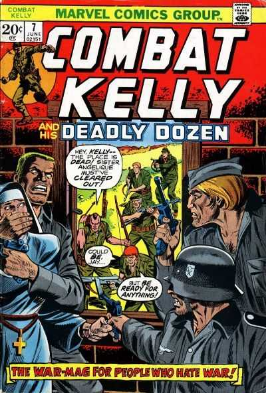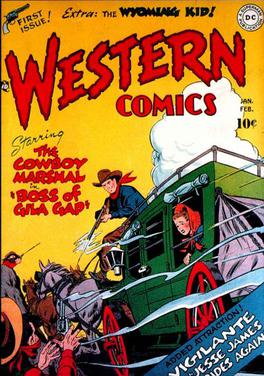
Sgt. Fury and his Howling Commandos is a comic book series created by Jack Kirby and Stan Lee and published by Marvel Comics from 1963 to 1981. The main character, Sgt. Nick Fury, later became the leader of Marvel's super-spy agency, S.H.I.E.L.D. The title also featured the Howling Commandos, a fictional World War II unit that first appeared in Sgt. Fury and his Howling Commandos #1.

Gold Key Comics was an imprint of American company Western Publishing, created for comic books distributed to newsstands. Also known as Whitman Comics, Gold Key operated from 1962 to 1984.

Donald L. Heck was an American comics artist best known for co-creating the Marvel Comics characters Iron Man, the Wasp, Black Widow, Hawkeye and Wonder Man and for his long run penciling the Marvel superhero-team series The Avengers during the 1960s Silver Age of comic books.

Bulletman and Bulletgirl are fictional superheroes originally published by Fawcett Comics.

Captain Marvel Adventures is a long running comic book anthology series that was published by Fawcett Comics, starring Captain Marvel during the Golden Age of Comic Books.

Hoppy the Marvel Bunny is a fictional character appearing in American comic books originally published by Fawcett Comics and later DC Comics as a spin-off of Captain Marvel. He was created by Chad Grothkopf (1914–2005), and debuted in Fawcett's Funny Animals #1. A comic book superhero and an anthropomorphic animal, Hoppy has made periodic appearances in stories related to Captain Marvel, today also known as Shazam or The Captain.

The All-Winners Squad is a fictional superhero team appearing in American comic books published by Marvel Comics. The company's first such team, it first appeared in All Winners Comics #19, published by Marvel predecessor Timely Comics during the period fans and historians call the Golden Age of Comic Books.

Daredevil is a fictional superhero created by Jack Binder, who starred in comics from Lev Gleason Publications during the 1930s–1940s period historians and fans call the Golden Age of comic books before being retroactively established into the Image Universe by Image Comics in the 1990s as its first character. The character is unrelated to Marvel Comics' Daredevil, and recent renditions of the character have often renamed him Doubledare or The Death-Defying Devil to avoid confusion and potential lawsuits.

The Yellow Claw is a supervillain appearing in American comic books published by Marvel Comics. Created by writer Al Feldstein and artist Joe Maneely, the character first appeared in Yellow Claw #1, published by Atlas Comics, the 1950s predecessor of Marvel.

Gary Friedrich was an American comic book writer best known for his Silver Age stories for Marvel Comics' Sgt. Fury and his Howling Commandos and in the following era, the series The Monster of Frankenstein, as well as for cocreating the supernatural motorcyclist Ghost Rider and the supernatural hero the Son of Satan.
Leave It to Binky is a teen-humor comic book series published by DC Comics that ran for 82 issues, first appearing in 1948 and wrapping up in 1977.

Captain Victory is a comic book originally created, written and drawn by Jack Kirby. It was first published by American comic book publisher Pacific Comics in 1981. Kirby agreed to create a comic for the fledgling publisher because Pacific promised him full creative control, and ownership of the characters.

Fatman the Human Flying Saucer is a fictional character, a comic book superhero created by artist C. C. Beck and writer Otto Binder in the 1960s.
Samuel Joseph Glanzman was an American comics artist and memoirist. Glanzman is best known for his Charlton Comics series Hercules, about the mythological Greek demigod; his autobiographical war stories about his service aboard the U.S.S. Stevens for DC Comics and Marvel Comics; and the Charlton Comics Fightin' Army feature "The Lonely War of Willy Schultz", a Vietnam War-era serial about a German-American U.S. Army captain during World War II.
The Masked Raider is an alias of several fictional characters appearing in American comic books published by Marvel Comics. The original character went by the name of Jim Gardley and appeared in comic books published during the 1930s and 1940s period known as the Golden Age of Comic Books, he was created by writer and artist Al Anders. Jim Gardley was a gunslinger and former rancher active during the American frontier. He was one of the few individuals that held the Eternity Mask for a short period, and succeeded by Dirk Mehler. In Marvel Comics #1000, it was revealed how the Golden Age Masked Raider died and a new character, initially unnamed but later unidentified as Carlo Zota, had taken up the name, also in possession of the Eternity Mask.
John Edmond Sparling, was a Canadian comics artist.

Ziggy Pig and Silly Seal are fictional, talking animal comic-book characters created by cartoonist Al Jaffee for Marvel Comics' 1940s predecessor, Timely Comics, during the period fans and historians call the Golden Age of Comic Books.
The Leatherneck Raiders are a fictional World War II unit appearing in American comic books published by Marvel Comics. Created by Gary Friedrich and Dick Ayers, they were a specially trained tactical commando squad. "Leatherneck" is a military slang term for a member of the United States Marine Corps, the Marine Raiders were a special World War II unit. The character Captain Savage is unrelated to the 1939 Fox Feature Syndicate character of that name.

Combat Kelly and the Deadly Dozen is a comic book series published by Marvel Comics from 1972 to 1973. The series was created by writer Gary Friedrich and penciler Dick Ayers, the creative team of Marvel's long-running World War II title Sgt. Fury and his Howling Commandos. The premiere issue continued a story that began in Sgt. Fury #98, and occasional crossovers continued between these two series. The series lasted for nine issues and was cover-billed simply as Combat Kelly in the postal indicia. With issue #5, the cover title changed slightly to Combat Kelly and his Deadly Dozen. The series name and premise are similar to those of the 1960s film The Dirty Dozen. The series was the second to feature a character by the name of Combat Kelly.

Western Comics is a Western comic book series that was published by DC Comics. DC's longest-running Western title, it published 85 issues from 1948 to 1961. Western Comics was an anthology series, featuring such characters as the wandering cowboy the Wyoming Kid, the Native American lawman Pow Wow Smith, the Cowboy Marshal, Jim Sawyer, showman Rodeo Rick, and Matt Savage, Trail Boss. The masked Vigilante Greg Saunders appeared in the first four issues of the title, but was soon replaced by itinerant fix-it man Nighthawk.















